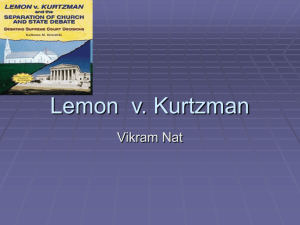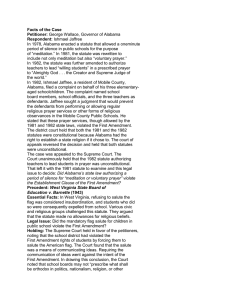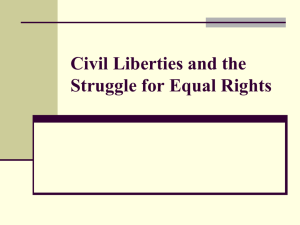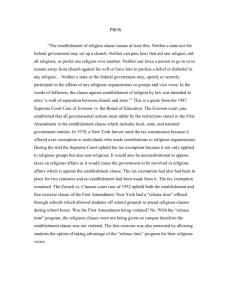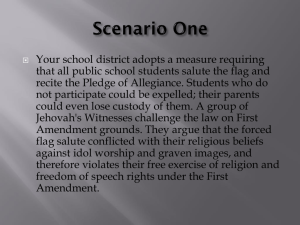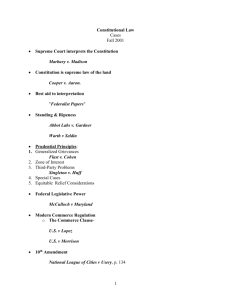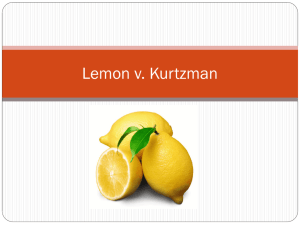Freedom of Religion - Solon City Schools
advertisement
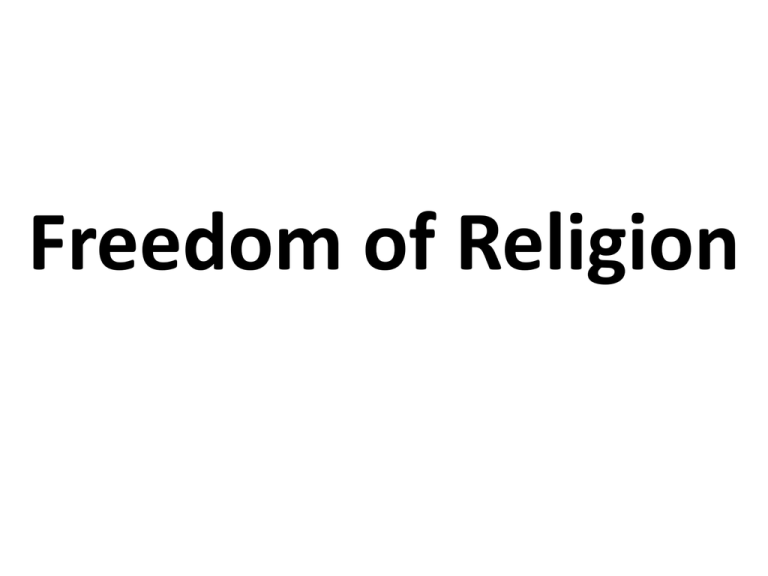
Freedom of Religion Reynolds v. US 1878 Facts of the Case • George Reynolds, secretary to Mormon Church leader Brigham Young, challenged the federal antibigamy statute. Reynolds was convicted in a Utah territorial district court. His conviction was affirmed by the Utah territorial supreme court. Question • Does the federal anti-bigamy statute violate the First Amendment's free exercise clause because plural marriage is part of religious practice? Conclusion: 9 for US, 0 for Reynolds • The court held that the statute can punish criminal activity without regard to religious belief. The First Amendment protected religious belief, but it did not protect religious practices that were judged to be criminal such as bigamy. Those who practice polygamy could no more be exempt from the law than those who may wish to practice human sacrifice as part of their religious belief. Everson v. Board of Education 1947 Facts of the Case • A New Jersey law allowed reimbursements of money to parents who sent their children to school on buses operated by the public transportation system. Children who attended Catholic schools also qualified for this transportation subsidy. Question • Did the New Jersey statute violate the Establishment Clause of the First Amendment as made applicable to the states through the Fourteenth Amendment? Conclusion: 5 for NJ, 4 for Everson • No. A divided Court held that the law did not violate the Constitution. The law did not pay money to parochial schools, nor did it support them directly in anyway. It was simply a law enacted as a "general program" to assist parents of all religions with getting their children to school. This was the first Supreme Court case incorporating the Establishment Clause of the First Amendment as binding upon the states through the Due Process Clause of the Fourteenth Amendment. • Both Justice Hugo Black's majority opinion and Justice Wiley Rutledge's dissenting opinion defined the First Amendment religious clause in terms of a "wall of separation between church and state". Engle v. Vitale 1962 Facts of the Case • The Board of Regents for the State of New York authorized a short, voluntary prayer for recitation at the start of each school day. This was an attempt to defuse the politically potent issue by taking it out of the hands of local communities. The blandest of invocations read as follows: "Almighty God, we acknowledge our dependence upon Thee, and beg Thy blessings upon us, our teachers, and our country." Question • Does the reading of a nondenominational prayer at the start of the school day violate the "establishment of religion" clause of the First Amendment? Conclusion: 6 for Engel, 1 vote for Vitale • Yes. Neither the prayer's nondenominational character nor its voluntary character saves it from unconstitutionality. By providing the prayer, New York officially approved religion. This was the first in a series of cases in which the Court used the Establishment Clause to eliminate religious activities of all sorts. Epperson v. Arkansas 1968 Facts of the Case • The Arkansas legislature passed a law prohibiting teachers in public or state- supported schools from teaching, or using textbooks that teach, human evolution. Susan Epperson, a public school teacher, sued, claiming the law violated her First Amendment right to free speech as well as the Establishment Clause. The State Chancery Court ruled that it violated his free speech rights; the State Supreme Court reversed. Question • Does a law forbidding the teaching of evolution violate either the free speech rights of teachers or the Establishment clause of the First Amendment? Conclusion: 9 for Epperson, 0 for Arkansas • Yes. Seven members of the Court held that the statute violated the Establishment Clause. Writing for the Court, Justice Fortas stated that the law had been based solely on the beliefs of fundamentalist Christians, who felt that evolutionary theories directly contradicted the biblical account of Creation. This use of state power to prohibit the teaching of material objectionable to a particular sect ammounted to an unconstitutional Establishment of Religion. Lemon v. Kurtzman 1971 Facts of the Case • The case involved controversies over laws in Pennsylvania and Rhode Island. In PA, a statute provided financial support for teacher salaries, textbooks, and instructional materials for secular subjects to non-public schools. The RI statute provided direct supplemental salary payments to teachers in non-public schools. Each statute made aid available to "church-related educational institutions." Question • Did the Rhode Island and Pennsylvania statutes violate the First Amendment's Establishment Clause by making state financial aid available to "church- related educational institutions"? Conclusion: 8 for Lemon, 0 for Kurtzman • Yes. Writing for the majority, Chief Justice Burger articulated that to be constitutional, a statute must have "a secular legislative purpose," it must have principal effects which neither advance nor inhibit religion, and it must not foster "an excessive government entanglement with religion." Wisconsin v. Yoder 1972 Facts of the Case • Jonas Yoder and Wallace Miller, both members of the Old Order Amish religion, and Adin Yutzy, a member of the Conservative Amish Mennonite Church, were prosecuted under a Wisconsin law that required all children to attend public schools until age 16. The three parents refused to send their children to such schools after the eighth grade, arguing that high school attendance was contrary to their religious beliefs. Question • Did Wisconsin's requirement that all parents send their children to school at least until age 16 violate the First Amendment by criminalizing the conduct of parents who refused to send their children to school for religious reasons? Conclusion: 7 for Yoder, 0 for Wisconsin • In a unamimous decision, the Court held that individual's interests in the free exercise of religion under the First Amendment outweighed the State's interests in compelling school attendance beyond the eighth grade. In the majority opinion the Court found that the values and programs of secondary school were "in sharp conflict with the fundamental mode of life mandated by the Amish religion," and that an additional one or two years of high school would not produce the benefits of public education cited by Wisconsin to justify the law. Wallace v. Jaffree 1985 Facts of the Case • An Alabama law authorized teachers to conduct regular religious prayer services and activities in school classrooms during the school day. Three of Jaffree's children attended public schools in Mobile. Question • Did Alabama law violate the First Amendment's Establishment Clause? BKGVBZD _s-xclick Conclusion: 6 for Jaffree, 3 for Wallace • Yes. The Court determined the constitutionality of Alabama's prayer and meditation statute by applying the secular purpose test, which asked if the state's actual purpose was to endorse or disapprove of religion. The Court held that Alabama's passage of the prayer and meditation statute was an affirmative endorsement of religion. As such, the statute clearly lacked any secular purpose as it sought to establish religion in public schools, thereby violating the First Amendment's Establishment Clause. BOE Westside v. Mergens 1990 Facts of the Case • The school administration at Westside HS denied permission to a group of students to form a Christian club with the same privileges and meeting terms as other Westside after-school student clubs. In addition to citing the Establishment Clause, Westside refused the club's formation because it lacked a faculty sponsor. When the school board upheld the administration's denial, Mergens and several other students sued. The students alleged that Westside's refusal violated the Equal Access Act, which requires that schools in receipt of federal funds provide "equal access" to student groups seeking to express "religious, political, philosophical, or other content" messages. Question • Was Westside's prohibition against the formation of a Christian club consistent with the Establishment Clause, thereby rendering the Equal Access Act unconstitutional? Conclusion: 8 for Mergens, 1 for BOE • No. In distinguishing between "curriculum" and "noncurriculum student groups," the Court held that since Westside permitted other non-curricular clubs, it was prohibited under the Equal Access Act from denying equal access to any after-school club based on the content of its speech. The proposed Christian club would be a non-curriculum group since no other course required students to become its members, its subject matter would not actually be taught in classes, it did not concern the school's cumulative body of courses, and its members would not receive academic credit for their participation.
